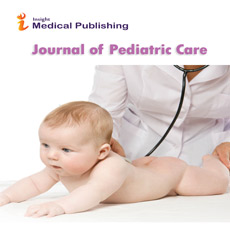Nodules on the Thyroid in Children and Adolescents
Eric Samson*
School of Nursing, Sun Yat-sen University, Guangzhou, China
- Corresponding Author:
- Eric Samson
School of Nursing,
Sun Yat-sen University, Guangzhou,
China,
E-mail: Samson_E@Led.cn
Received date: February 21, 2023, Manuscript No. IPJPC-23-16498; Editor assigned: February 24, 2023, PreQC No. IPJPC-23-16498(PQ); Reviewed date: March 10, 2023, QC No. IPJPC-23-16498; Revised date: March 17, 2023, Manuscript No. IPJPC-23-16498(R); Published date: March 24, 2023, DOI: 10.4172/2469-5653.9.1.178
Citation: Samson E (2023) Nodules on the Thyroid in Children and Adolescents. J Pediatr Vol. 9 No. 1: 178
Description
Thyroid nodules that can be seen in the clinic are less common in children than in adults. On the other hand, there is a link between them and an increased chance of cancer. As a result, pediatric thyroid nodules require comprehensive evaluation and it is essential to comprehend the characteristics associated with a higher risk of malignancy in order to direct treatment and referral. The genetics, presentation, response to treatment and prognosis of pediatric thyroid cancer are significantly different from those of adults. Kids frequently present with further developed infection, however by far most have brilliant long haul anticipation. Thyroid nodule and thyroid cancer treatment necessitate the participation of experts with prior experience as well as a multidisciplinary team approach. The current approaches to treating pediatrics thyroid nodules and cancer are outlined, as are the investigational pathways for children's thyroid nodules. He assessed pervasiveness of strong thyroid knobs in youngsters is 1%-1.7% with rate expanding with age. Thyroid abnormalities, including nodules or cystic lesions, are seen in 20%–57% of children who have ultrasounds of the neck for various reasons. The incidence of malignancy in a single paediatric thyroid nodule is between 19 and 26.4%, which is higher than the 5% incidence that is seen in adults. Therefore, pediatric practice necessitates familiarity with the evaluation of thyroid nodules in children.
Risk Factors
Thyroid nodules are differentially diagnosed with structural, developmental and non-neoplastic lesions, as well as benign and malignant neoplasms. The American Thyroid Association (ATA) 2015 guidelines do not recommend the use of ultrasound as a screening tool due to inconclusive evidence that early diagnosis of clinically undetectable lesions impacts the outcome. A clinical history should include an assessment for risk factors for malignancy, including radiation exposure, chemotherapy, family history (especially for Medullary Thyroid Carcinoma (MTC)), autoimmune thyroiditis and endemic iodine deficiency (for follicular carcinoma). Thyroid irradiation is associated with a higher risk of thyroid cancer in people who were exposed at a younger age and who received a scatter dose. Radiation portions >30 present a lower risk, potentially on the grounds that higher dosages prompt cell passing instead of substantial mutations. There is much of the time a long inactivity period; thyroid tumors may be seen in certain syndromes, such as the carney complex, familial adenomatous polyposis. A family history of MTC, parathyroid adenoma, or phaeochromocytoma may suggest Multiple Endocrine Neoplasia type 2 (MEN2) syndromes. Adult studies have demonstrated a clear. A recent meta-analysis showed that the incidence of PTC in children with AT varied between 0.7 and 7.8%, with higher incidence in those with positive thyroid antibodies and higher TSH levels. Current guidelines recommend that an ultrasound be performed in children with AT if there is a palpable nodule, gland asymmetry, or cervical lymphadenopathy on examination. However, there is variation in practice, with some physicians performing routine ultrasounds in all patients with AT.
Thyroid Antibodies
During the physical examination, it is determined whether the nodule is single or multiple, as well as whether cervical lymphadenopathy is present. Examining for any indications of hyperthyroidism or local compression is crucial. Given the risk of diffuse sclerosing form of PTC in children, a diffuse increase in the size of a lobe or the entire thyroid gland should prompt imaging. Examination findings suggestive of malignancy include a clinically palpable nodule, larger nodule size, thyroid asymmetry, firm consistency, the presence of cervical lymphadenopathy and increasing nodule size. Examinations incorporate thyroid capability tests and against thyroid antibodies. Because medullary cells produce calcitonin, serum calcitonin levels should be measured if MEN2 is suspected. Hyperthyroidism with suppressed TSH suggests a toxic nodule. Medullary thyroid cancer may be detected by a high serum level. The revelation of a medullary thyroid disease ought to incite examinations for phaeochromocytoma before any employable thyroid mediation. The first imaging test for thyroid nodules is ultrasound, which is used to determine whether or not fine need aspiration biopsy (FNAB) and/or surgical resection are necessary and when. In addition, in cases of biochemical hyperthyroidism, a 99 mTc pertechnetate diagnostic scan is recommended to identify the underlying cause (such as a toxic nodule, which is uncommon in children). Because of the significant variability between operators, ultrasounds should only be performed and reported by technicians and radiologists who are familiar with paediatric thyroid nodules. In a similar vein, pediatric thyroid biopsies should only be performed by radiologists or surgeons who are highly skilled in such procedures. Additionally, pediatric endocrinologists or general paediatricians with expertise in the management of thyroid nodules should oversee or consult with pediatricians. The clinical and radiological features are used to determine whether or not an FNAB should be performed. In the two grown-ups and kids, bigger knob size is related with an expanded threat risk. In any case, outright size isn't as useful in youngsters, where the choice to FNAB depends on ultrasound highlights, span development and the presence of cervical lymphadenopathy. Given the shortfall of authoritative models, the creators prescribe that the choice to FNAB be attempted after multidisciplinary conversation including experienced pediatric radiologists, specialists and endocrinologists.
Open Access Journals
- Aquaculture & Veterinary Science
- Chemistry & Chemical Sciences
- Clinical Sciences
- Engineering
- General Science
- Genetics & Molecular Biology
- Health Care & Nursing
- Immunology & Microbiology
- Materials Science
- Mathematics & Physics
- Medical Sciences
- Neurology & Psychiatry
- Oncology & Cancer Science
- Pharmaceutical Sciences
